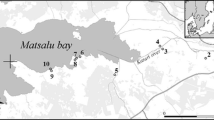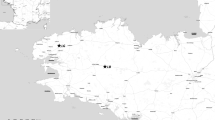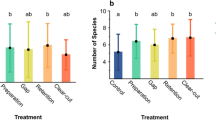Abstract
The main objective of this paper is to report the effect of shrub removal and mowing on the diversity and composition of ground-dwelling spider assemblages in Natura 2000 habitats of Mátra Mountains. We found significant effects of shrub removal and mowing on spider communities. Diversity decreased in the year following shrub removal but increased in the following years. Spider diversity in the final year decreased due to the lack of additional treatments. During our study the hay meadows were the most diverse habitats compared to control shrubs and treated shrubs. Treatments caused changes in community structure: the highest number of generalist species was observed in the treated shrubs, and the highest density of rare and protected species in the hay meadows. The high species turnover observed between hay meadows and control shrubs reflects the importance of grassland management. We conclude that shrub removal an effective grassland management action to increase spiders diversity in Natura 2000 habitats. Finally, treated shrubs require additional treatments such as mowing to ensure the spider communities inhabiting them are as diverse as those inhabiting meadows.
Similar content being viewed by others
References
Albrecht M., Schmid B. & Obrist M.K. 2010. Effects of ecological compensation meadows on arthropod diversity in adjacent intensively managed grassland. Biol. Conserv. 143 (3): 642–649. DOI: https://doi.org/10.1016/j.biocon.2009.11.029
Bartha S. 2007. Kompozíció, differenciálódás és dinamika az erd˝ossztyep biom gyepjeiben [Composition, differentiation and dynamics in the forest steppe biome], Chapter 6, pp. 194–210. In: Illyés E. & Bölöni J. (eds), Lejt˝osztyeppek, löszgyepek és erd˝ossztyepprétek Magyarországon [Slope Steppes, Loess Steppes and Forest Steppe Meadows in Hungary], MTAÖBKI, Budapest, 236 pp. ISBN: 978-963-06-3673-5
Buchar J. & Růžička V. 2002. Catalogue of Spiders of the Czech Republic. Library of Congress Cataloging in Publication Data, 352 pp. ISBN: 80-86-360-25-3
Buttler A. 1992. Permanent plot research in wet meadows and cutting experiment. Vegetatio 103 (2): 113–124. DOI: https://doi.org/10.1007/BF00047697
Blandin P. 1986. Bioindicateurs et diagnostic des syst`emes écologiques. Bulletin d’´Ecologie 17 (4): 215–307.
Bock A., Sparks T.H., Estrella N. & Menzel A. 2013. Changes in the timing of hay cutting in Germany do not keep pace with climate warming. Global Change Biol. 19 (10): 3123–3132. DOI: https://doi.org/10.1111/gcb.12280
Connell J.H. 1978. Diversity of tropical rainforests and coral reefs. Science 199 (4335): 1304–1310. DOI: https://doi.org/10.1126/science.199.4335.1302
Costley J. 2015. Meadow management increased plant species diversity in a species-poor, neutral grassland in Herefordshire, UK. Conservation Evidence 12: 40–42.
Curry J.P. 1994. Grassland Invertebrates: Ecology, Influence on Soil Fertility and Effects on Plant Growth. Chapman & Hall, London, 437 pp. ISBN: 978-0-412-16520-7
Decleer K. 1990. Experimental cutting of reedmarsh vegetation and its influence on the spider (Araneae) fauna in the Blankaart naturereserve, Belgium. Biol. Conserv. 52 (3): 161–185. DOI: https://doi.org/10.1016/0006-3207(90)90124-8
Dekoninck W., Hendrickx F., Dethier M. & Maelfait J.-P. 2009. Forest succession endangers the special ant fauna of abandoned quarries along the River Meuse (Wallonia, Belgium). Restor. Ecol. 18 (5): 681–690. DOI: https://doi.org/10.1111/j.1526-100X.2008.00499.x
Dennis P., Young M.R. & Bentley C. 2001. The effects of varied grazing management on epigeal spiders, harvestmen and pseudoscorpions of Nardus strict a grassland in upland Scotland. Agric. Ecosyst. Environ. 86 (1): 39–57. DOI: https://doi.org/10.1016/S0167-8809(00)00263-2
Entling W., Schmidt M.H., Bacher S., Brandl R. & Nentwig W. 2007. Niche properties of Central European spiders: shading, moisture and the evolution of the habitat niche. Global Ecol. Biogeogr. 16 (4): 440–448. DOI: https://doi.org/10.1111/j.1466-8238.2006.00305.x
Grandchamp A., Bergamini A., Stofer S., Niemela J., Duelli P. & Scheidegger C. 2005. The influence of grassland management on ground beetles (Carabidae, Coleoptera) in Swiss montane meadows. Agric. Ecosyst. Environ. 110 (3-4): 307–317. DOI: https://doi.org/10.1016/j.agee.2005.04.018
Güsewell S., Buttler A. & Klötzli F. 1998. Short-term and longterm effects of mowing on the vegetation of two calcareous fens. J. Veg. Sci. 9 (6): 861–872. DOI: https://doi.org/10.2307/3237051
Hammer Ø., Harper D.A.T. & Ryan P.D. 2001. PAST: Paleontological Statistics software package for education and data analysis. Palaeontol. Electron. 4 (1): article 4, 9 pp.
Harris R., York A. & Beattie A.J. 2003. Impacts of grazing and burning on spider assemblages in dry eucalypt forests of north–eastern New South Wales, Australia. Austral. Ecol. 28 (5): 526–538. DOI: https://doi.org/10.1046/j.1442-9993.2003.01310.x
Hatley C.L. & MacMahon J.A. 1980. Spider community organization; seasonal variation and the role of vegetation architecture. Environ. Entomol. 9 (5): 632–639. DOI: https://doi.org/10.1093/ee/9.5.632
Hill T.C.J., Walsh K.A., Harris J.A. & Moffett B.F. 2003. Using ecological diversity measures with bacterial communities. FEMS Microbiol. Ecol. 43 (1): 1–11. DOI: https://doi.org/10.1111/j.1574-6941.2003.tb01040.x
Homburger H. & Hofer G. 2012. Diversity change of mountain hay meadows in the Swiss Alps. Basic. Appl. Ecol. 13 (2): 132–138. DOI: https://doi.org/10.1016/j.baae.2011.12.004
Hulbert L.C. 1988. Causes of fire effects in tallgrass prairie. Ecology 69: 46–58.
Humbert J.Y., Ghazoul J. & Walter T. 2009. Meadow harvesting techniques and their impacts on field fauna. Agric. Ecosyst. Environ. 130 (1-2): 1–8. DOI: https://doi.org/10.1016/j.agee.2008.11.014
Ilmarinen K. & Mikola J. 2009. Soil feedback does not explain mowing effects on vegetation structure in a seminatural grassland. Acta Oecol. 35 (6): 838–848. DOI: https://doi.org/10.1016/j.actao.2009.08.008
Kohyani P.T., Bossuyt B., Bonte D & Hoffmann M. 2008. Grazing as a management tool in dune grasslands: Evidence of soil and scale dependence of the effect of large herbivores on plant diversity. Biol. Conserv. 141 (6): 1687–1694. DOI: https://doi.org/10.1016/j.biocon.2008.04.010
Maelfait J.P, Baert L., Bonte D., Bakker D., Gurdebeke S. & Hendrickx F. 2004. The use of spiders as indicators of habitat quality and anthropogenic disturbance in Flanders, Belgium. European Arachnology 2002, pp. 129–141.
Malumbres-Olarte A., Vink C.J., Ross J.G., Ruickshank R.H. & Paterson A.M. 2013. The role of habitat complexity on spider communities in native alpine grasslands of New Zealand. Insect. Conserv. Divers. 6 (2): 124–134. DOI: https://doi.org/10.1111/j.1752-4598.2012.00195.x
Magos G., Szabó Sz., Szuromi L. & Urbán L. 2010. Természetvédelem a Mátrai tájegységben [Nature conservation in the Mátra region], pp. 373–398. In: Baráz Cs., Dudás Gy., Holló S., Szuromi L. & Vojtkó A. (eds), A Mátra Tájvédelmi Körzet. Heves és Nógrág határán. [Mátra Mts. Conservation Area: At the Border of Heves and Nógrád Counties], Bükki Nemzeti Park Igazgatóság Monográfiái, [Monographs of the Bükki National Park Directorate], 4, Eger, 431 pp.
Magurran A.E. 2003. Measuring Biological Diversity. Blackwell Publishing, Oxford, 264 pp. ISBN: 978-0-632-05633-0
Maret M.P. & Wilson M.V. 2000. Fire and seedling population dynamics in western Oregon prairies. J. Veg. Sci. 11 (2): 307–314. DOI: https://doi.org/10.2307/3236811
Margalef R. 1958. Temporal succession and spatial heterogeneity in phytoplankton, pp. 323–347. In: Buzzati-Traverso A.A. (ed.), Symposium on Perspectives in Marine Biology, Conference Paper and Proceedings, Buzzati-Traverso Univ. Calif. Press, Berkeley, 621 pp.
Máthé I. & Balázs E. 2006. Az emberi zavarás futóbogarakra gyakorolt hatásának vizsgálata Erdélyben [Investigating the effect of human disturbance on ground beetles in Transylvania]. Állattani Közlem. 91 (1): 57–68.
Morris M.G. 2000. The effects of structure and its dynamics on the ecology and conservation of arthropodsin British grasslands. Biol. Conserv. 95 (2): 129–142. DOI:https://doi.org/10.1016/S0006-3207(00)00028-8
Munguira M.L. & Thomas J.A. 1992. Use of road verges by butterfly and burnet populations, and the effect of roads on adult dispersal and mortality. J. Appl. Ecol. 29 (2): 316–329. DOI: https://doi.org/10.2307/2404501
Nagendra H. 2002. Opposite trends in response for the Shannon and Simpson indices of landscape diversity. Appl. Geogr. 22 (2): 175–186. DOI: https://doi.org/10.1016/S0143-6228(02)00002-4
Noordijk J., Delille K., Schaffers A.P. & Sýkora K.V. 2009a. Optimizing grassland management for flower-visiting insects in roadside verges. Biol. Conserv. 142 (10): 2097–2103. DOI: https://doi.org/10.1016/j.biocon.2009.04.009
Noordijk J., Schaffers A.P., Heijermanb T., Boerc P., Gleichmana M & Sýkora K.V. 2010. Effects of vegetation management by mowing on ground-dwelling arthropods. Ecol. Eng. 36 (5): 740–750. DOI: https://doi.org/10.1016/j.ecoleng.2010.01.003
Pearce J.L., Schuurman D., Barber K.N., Larrivee M., Venier L.A., McKee J. & McKenney D. 2005. Pitfall trap designs to maximize invertebrate captures and minimize captures of nontarget vertebrates. Canad. Entomol. 137 (2): 233–250. DOI: https://doi.org/10.4039/N04-029
Pozzi S., Gonseth Y. & Hanggi A. 1998. Evaluation of dry grassland management on the Swiss occidental plateau using spider communities (Arachnida: Araneae). Rev. Suis. Zool. 105 (3): 465–485.
Rákóczi A.M. & Samu F. 2012. Természetvédelmi célú orgonairtás rövid távú hatása pókegyüttesekre [The short term effect of Syringa eradication conservation management on spider assemblages]. Rosalia 8: 141–149.
Rushton S.P. 1988. The effects of scrub management regimes on the spider fauna of chalk grassland, castor hanglands national nature reserve, Cambridgeshire, UK. Biol. Conserv. 46 (3): 169–182. DOI: https://doi.org/10.1016/0006-3207(88)90066-3
Ryser P., Lagenhauer R & Gigon A. 1995. Species richness and vegetation structure in a limestone grassland after 15 years management with six biomass removal regimes. Folia Geobot. Phytotax. 30 (2): 157–167. DOI: https://doi.org/10.1007/BF02812095
Schlesinger W.H., Reynolds J.F., Cunningham G.L., Huenneke L.F., Jarrell W.M., Virginia R.A. & Whitford W.G. 1990. Biological feedbacks in global desertification. Science 247 (4946): 1043–1048. DOI: https://doi.org/10.1126/science.247.4946.1043
Schmera D. & Er˝os T. 2008. A mintavételi er˝ofeszítés hatása a mintareprezentativitásra [The effect of sampling effort on sampling representativity]. Acta Biol. Debr. Suppl. Oecol. Hung. 18: 209–213.
Schwab A., Dubois D., Fried P.M. & Edwards P.J. 2002. Estimating the biodiversity of hay meadows in north-eastern Switzerlandon the basis of vegetation structure. Agric. Ecosyst. Environ. 93 (1-3): 197–209. DOI: https://doi.org/10.1016/S0167-8809(01)00347-4
Steffan-Dewenter I. & Leschke K. 2002. Effects of habitat management on vegetation and above-ground nesting bees and wasps of orchard meadows in Central Europe. Biodivers. Conserv. 12 (9): 1953–1968. DOI: https://doi.org/10.1023/A:1024199513365
Tews J., Brose U. & Grimm V. 2004. Animal species diversity driven by habitat heterogeneity/diversity: the importance of keystone structures. J. Biogeogr. 31 (1): 79–92. DOI: https://doi.org/10.1046/j.0305-0270.2003.00994.x
Zschokke S. 1996. Early stages of web construction in Araneus diadematus Clerck. Rev. Suisse Zool. vol. hors série: 709–720.
Author information
Authors and Affiliations
Corresponding author
Rights and permissions
About this article
Cite this article
Szmatona-Túri, T., Vona-Túri, D., Magos, G. et al. The effect of grassland management on diversity and composition of ground-dwelling spider assemblages in the Mátra Landscape Protection Area of Hungary. Biologia 72, 642–651 (2017). https://doi.org/10.1515/biolog-2017-0075
Received:
Accepted:
Published:
Issue Date:
DOI: https://doi.org/10.1515/biolog-2017-0075




